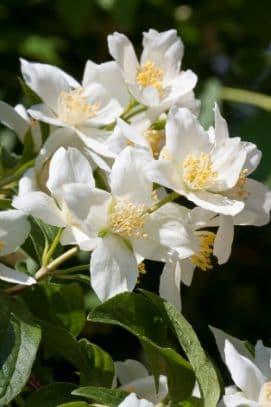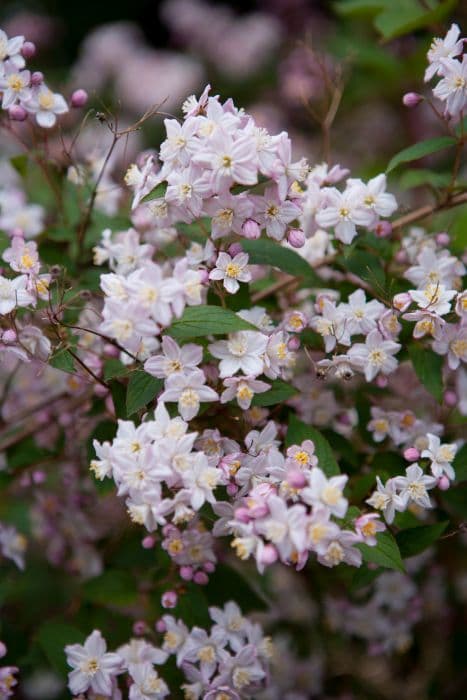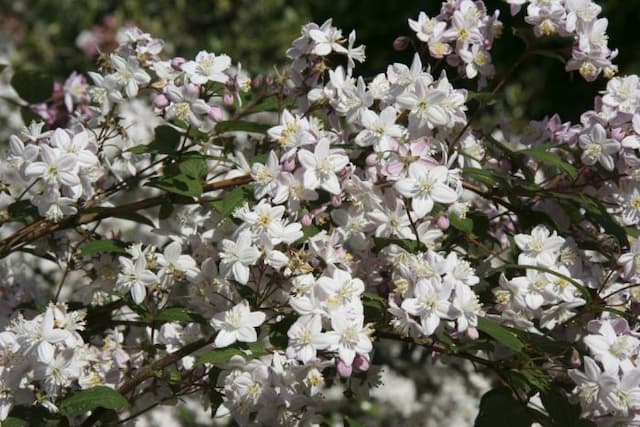Gordon's Mock Orange Philadelphus lewisii var. gordonianus

ABOUT
Commonly known as Gordon's mock-orange, this plant is a deciduous shrub that boasts an appealing aesthetic. It is adorned with an abundant display of white flowers that are notable for their delicate, cup-shaped form and their clustered arrangement. The blossoms exude a captivating fragrance that is reminiscent of orange blossoms, adding to the allure of the plant. Its leaves are medium to dark green, presenting an ovate shape with pointed tips and slightly serrated edges, contributing to its lush appearance. The bark of the shrub is textured and adds a touch of rustic charm to its overall look. Blooming primarily occurs in the late spring to early summer, creating a standout visual and olfactory experience in any garden setting where it is featured.
About this plant
 Names
NamesFamily
Hydrangeaceae.
Synonyms
Gordon's Mockorange, Wild Mock Orange, Lewis' Mock Orange, Gordon's Syringa.
Common names
Philadelphus gordonianus Lindl., Philadelphus californicus Benth.
 Toxicity
ToxicityTo humans
Mock Orange, the plant in question, is not known to be toxic to humans. Generally, the plant is considered non-toxic and there are no well-documented cases or symptoms of poisoning from ingesting any part of this plant.
To pets
Mock Orange is generally recognized as non-toxic to pets. It is not associated with any significant toxicity risk to cats, dogs, or other domestic animals if they ingest parts of the plant. No symptoms of poisoning from Mock Orange have been commonly reported for pets.
 Characteristics
CharacteristicsLife cycle
Perennials
Foliage type
Deciduous
Color of leaves
Green
Flower color
White
Height
6-10 feet (1.8-3 meters)
Spread
6-8 feet (1.8-2.4 meters)
Plant type
Shrub
Hardiness zones
5
Native area
North America
Benefits
 General Benefits
General Benefits- Ornamental Value: Philadelphus lewisii var. gordonianus, commonly known as Mock Orange, has beautiful white flowers that are valued for their ornamental appeal.
- Fragrance: The Mock Orange is well-known for its delightful fragrance, which can enhance the sensory experience of any garden or landscape.
- Wildlife Attraction: The flowers attract pollinators such as bees and butterflies, supporting local ecosystems.
- Low Maintenance: Once established, Mock Orange is relatively low maintenance, requiring minimal care beyond occasional pruning.
- Drought Tolerance: It is fairly drought-tolerant, making it suitable for gardens in drier climates once fully established.
- Privacy Screen: When planted in groups or rows, Mock Orange can act as a natural privacy screen or hedge.
- Versatility in Landscaping: It can be used in various landscape designs, including as a specimen plant, in borders, or as part of a mixed shrubbery.
- Seasonal Interest: Apart from its spring blossoms, Mock Orange may also offer seasonal interest with its foliage turning yellow in the fall.
- Soil Adaptability: Mock Orange can thrive in a range of soil types, provided they are well-drained.
 Medical Properties
Medical PropertiesThis plant is not used for medical purposes.
 Air-purifying Qualities
Air-purifying QualitiesThis plant is not specifically known for air purifying qualities.
 Other Uses
Other Uses- Garden Boundaries: Philadelphus lewisii var. gordonianus, also known as mock orange, can be used to establish garden boundaries due to its dense foliage.
- Erosion Control: Its extensive root system helps to stabilize soil and control erosion on slopes and banks.
- Hedge Creation: Mock orange is often planted in rows to create an attractive and fragrant living hedge for privacy.
- Wildlife Habitat: The dense foliage provides shelter and nesting sites for birds, while the flowers attract butterflies and bees.
- Outdoor Events: Due to its strong, sweet fragrance, it's sometimes used as a natural backdrop for outdoor weddings and events.
- Dye Production: Traditional uses include making plant-based dyes from the bark for coloring fabrics or crafts.
- Education: This plant can be used in educational settings such as botanical gardens to teach about native plants and pollinators.
- Cultural Significance: In some cultures, mock orange branches are used in celebrations or as part of traditional costumes.
- Photography: Its beautiful blooms and overall structure make it an attractive subject for garden and nature photography.
- Sound Barrier: When planted in mass, mock orange can help reduce noise pollution by acting as a natural sound barrier.
Interesting Facts
 Feng Shui
Feng ShuiMock Orange is not used in Feng Shui practice.
 Plant Symbolism
Plant Symbolism- Renewal: As Philadelphus lewisii var. gordonianus, commonly known as Mock Orange, often blooms with bright, abundant flowers, it is seen as a symbol of renewal, representing the refreshing nature of spring and the beauty of new beginnings.
- Innocence: The white flowers of Mock Orange are commonly associated with purity and innocence, echoing the traditional symbolism of white blooms in various cultures.
- Hope: The hardiness of this plant and its capacity to rebound after the cold of winter suggest themes of hope and the idea that better times lie ahead.
- Eternal Love: The robust and lasting nature of the Mock Orange, coupled with its sweet fragrance, can represent the durability and sweetness of love that lasts through time.
- Memory: Sometimes, the Mock Orange's strong scent is tied to memory and nostalgia, evoking past experiences and the enduring nature of our recollections.
 Water
WaterThe Mock Orange should be watered deeply once a week, providing it with about 1 to 1.5 gallons of water each time. During hot and dry periods, increase the frequency to twice a week ensuring the soil remains moist but not waterlogged. Adjust watering during rainy periods to prevent overwatering. In winter, reduce watering as the plant's water requirements decrease. Always check the soil moisture before watering to gauge the plant's needs.
 Light
LightThe Mock Orange thrives best in full sun to partial shade conditions. Ideally, it should receive at least 6 hours of direct sunlight daily. An optimal spot would be where the plant is exposed to morning sunlight and receives some afternoon shade, especially in regions with very hot summers.
 Temperature
TemperatureMock Orange performs well in a temperature range between 60°F and 80°F, which are typical daytime temperatures for many temperate climates. It can withstand minimum temperatures down to about 20°F, making it hardy in many regions. Avoid placing the plant in areas where temperatures consistently exceed 90°F, as excessive heat may stress the plant.
 Pruning
PruningPruning the Mock Orange is essential to maintain shape, encourage bushier growth, and improve air circulation. Prune right after flowering, as the plant blooms on the previous year's growth. Remove any dead or overcrowded branches, and cut back about one-third of the oldest stems to promote new growth. Prune annually for best results.
 Cleaning
CleaningAs needed
 Soil
SoilMock Orange prefers well-drained, loamy soil enriched with organic matter. A pH between 6.0 and 7.5 is ideal for this plant. To create the best soil mix, combine two parts garden soil, one part sand, and one part compost to ensure good drainage and fertility.
 Repotting
RepottingMock Orange doesn't require frequent repotting; it is typically best to repot every 3 to 5 years or when it outgrows its current container. During repotting, gently loosen the root ball and trim any dead or excessively long roots.
 Humidity & Misting
Humidity & MistingMock Orange thrives in moderate humidity conditions, but is fairly adaptable and does not require specific humidity levels. It performs well in the average humidity found in most outdoor environments.
 Suitable locations
Suitable locationsIndoor
Place Mock Orange in bright, indirect light indoors.
Outdoor
Plant Mock Orange in well-draining soil and full sun.
Hardiness zone
3-9 USDA
 Life cycle
Life cycleThe common name for Philadelphus lewisii var. gordonianus is Gordon's mock-orange. Its life cycle begins with seed germination triggered by after-ripening requirements, that may include cold stratification. Following sprout emergence, the seedling phase sees the development of a root system and the first true leaves. As it enters the juvenile stage, the plant experiences rapid vegetative growth, eventually maturing into an adult that develops woody stems and a full crown of foliage. The adult plant produces fragrant white flowers in late spring to early summer, which are then pollinated and produce small, four-chambered seed capsules. Once mature, the seeds are dispersed, completing the cycle and beginning a new generation of plants.
 Propogation
PropogationPropogation time
Spring to early summer
The most popular method of propagating Mock Orange (Philadelphus lewisii var. gordonianus) is through softwood cuttings taken in late spring or early summer. To do this, select a healthy stem that has new growth and cut a piece about 4 to 6 inches (10 to 15 centimeters) long. The cut should be made just below a leaf node, and the lower leaves should be removed. Dip the cut end in rooting hormone to encourage root growth and insert the cutting into a pot filled with a well-draining soil mixture. Keep the soil moist and place the pot in a warm, bright spot out of direct sunlight. In a few weeks, the cutting should develop roots and can eventually be transplanted into the garden.








![Hydrangea [Early Sensation]](/_next/image?url=https%3A%2F%2Fplants-admin.emdemapps.com%2Fimages%2Fplants%2F%2Fimages%2F604b6150338db.png&w=640&q=75)
